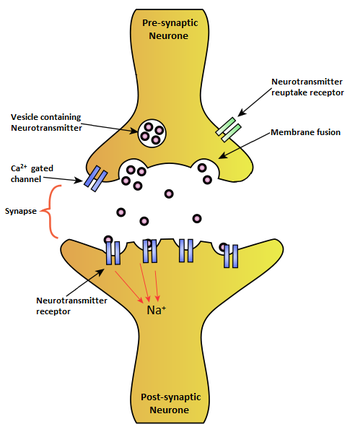Synapse
In the nervous system, a synapse is a structure that permits a neuron to pass an electrical or chemical signal to another cell (neural or otherwise). Synapses are essential to neuronal function; neurons are cells that are specialized to pass signals to individual target cells, and synapses are the means by which they do so.
Types of synapses
There are two fundamentally different types of synapses:
- In a chemical synapse, electrical activity in the presynaptic neuron is converted (via the activation of voltage-gated calcium channels) into the release of a chemical called a neurotransmitter that binds to receptors located in the postsynaptic cell, usually embedded in the plasma membrane. The neurotransmitter may initiate an electrical response or a secondary messenger pathway that may either excite or inhibit the postsynaptic neuron. Because of the complexity of receptor signal transduction, chemical synapses can have complex effects on the postsynaptic cell.
- In an electrical synapse, the presynaptic and postsynaptic cell membranes are connected by special channels called gap junctions that are capable of passing electric current, causing voltage changes in the presynaptic cell to induce voltage changes in the postsynaptic cell. The main advantage of an electrical synapse is the rapid transfer of signals from one cell to the next.
Mechanism of action
When an action potential reaches the synaptic knob, the calcium ion channels open and Ca2+ enters the synaptic knob. As the Ca2+ enters, the vesicles containing the neurotransmitters fuse with the membrane of the presynaptic neuron and the neurotransmitters are released into the synapse. The neurotransmitter molecules attach to the receptors on the sodium ion channels, which allow Na+ ions to diffuse into the postsynaptic neuron. This influx of Na+ generates a new action potential in the postsynaptic neuron. An enzyme is then released into the synapse that breaks the neurotransmitters down into small, precursor molecules. These fragments are reabsorbed by receptors on the presynaptic neuron and they are then used to remake the neurotransmitters. The neurotransmitters are then ready to release when a new action potential reaches the presynaptic neuron. This reabsorbing prevents the neurotransmitters from continuously binding with the sodium ion channels on the post-synaptic neuron and firing off repeated new action potentials.
Role in memory
It is widely accepted that the synapse plays a role in the formation of memory. As neurotransmitters activate receptors across the synaptic cleft, the connection between the two neurons is strengthened when both neurons are active at the same time, as a result of the receptor's signalling mechanisms. The strength of two connected neural pathways is thought to result in the storage of information, resulting in memory. This process of synaptic strengthening is known as long-term potentiation.
See also
External links
References
This article does not cite enough references. You can help by adding some. |
